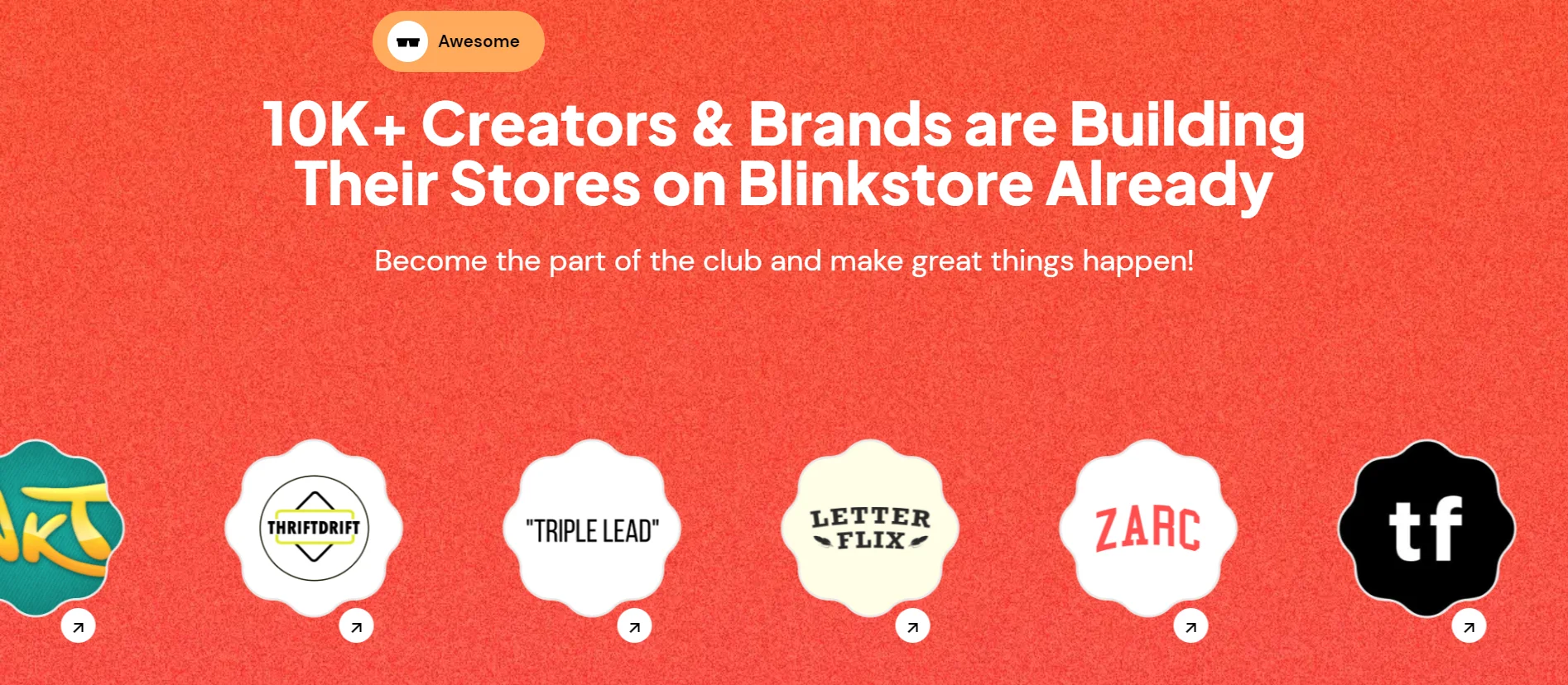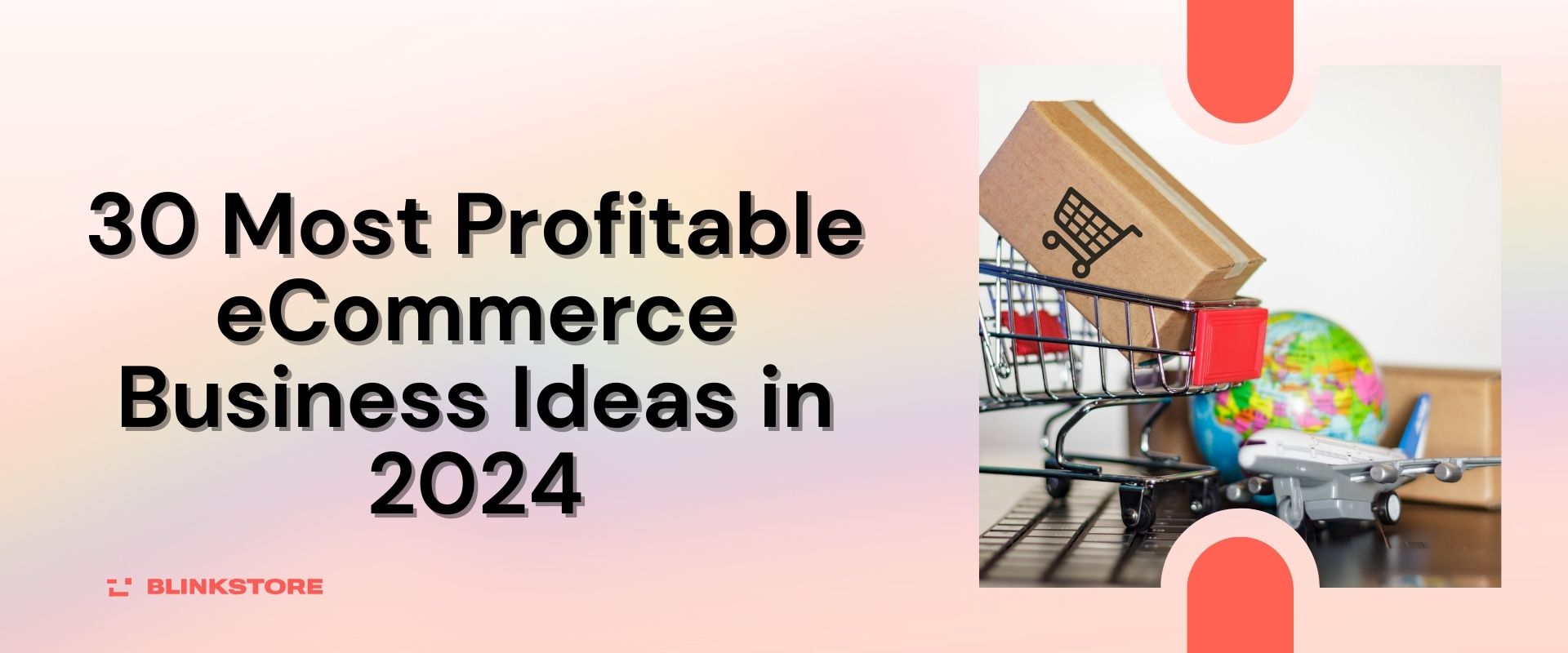Launching your online store is easier than ever, offering the thrill of being your own boss. Whether you have a niche in mind or are exploring options, eCommerce is a sea of potential. Our guide introduces 30 profitable eCommerce business ideas, diving into trends and real-world success stories. Let’s uncover the best eCommerce business ideas in 2024.
Table of Contents
By 2024, you’ll witness global retail eCommerce sales soaring to an impressive $6.3 trillion, exceeding 23% of total retail sales. This significant leap underscores the rising dominance of online shopping in the retail scene.
As you and fellow consumers increasingly opt for the convenience and varied choices offered by digital platforms, eCommerce is reshaping how we experience and engage with retail, playing a pivotal role in the evolving global economy. This is more of a reason to choose an eCommerce business idea.
Pros and Cons of eCommerce Business

Running an eCommerce business can be a lucrative venture, but like any business model, it comes with its own set of advantages and challenges. Here are the pros and cons of an eCommerce business:
Pros:
- Global Reach: eCommerce provides access to a global market. Your products can reach customers around the world, breaking down geographical barriers.
- 24/7 Availability: Your online store is open 24/7, allowing customers to shop at their convenience. This flexibility can lead to increased sales and customer satisfaction.
- Low Overhead Costs: eCommerce businesses often have lower operating costs. There’s no need for physical storefronts, and expenses like rent and utilities are minimized.
- Targeted Marketing: Digital marketing allows for precise targeting. You can tailor your advertising efforts to specific demographics, increasing the efficiency of your marketing budget.
- Data Analytics: eCommerce platforms provide robust analytics tools. You can gather valuable data on customer behavior, preferences, and buying patterns. Enabling data-driven decision-making.
- Scalability: It’s easier to scale an eCommerce business. Adding new products, expanding product lines, or reaching new markets can be achieved with relative ease compared to a physical store.
- Convenience for Customers: Online shopping offers convenience. Customers can browse and purchase products from the comfort of their homes, avoiding the need to travel to a physical store.
- Multiple Sales Channels: Beyond your own website, you can leverage various online marketplaces and platforms. This increases your product visibility and reach a broader audience.
- Customer Reviews and Feedback: Customers can leave reviews and feedback, providing valuable social proof for your products. Fostering trust among potential buyers.
Cons:
- Security Concerns: Security is a significant concern. eCommerce businesses are vulnerable to cyber threats, including data breaches and hacking attempts. Which can damage your reputation.
- Initial Set-up Costs: While operating costs can be lower, the initial set-up of an eCommerce website might need a significant investment in website development, design, and marketing.
- Dependency on Technology: eCommerce relies heavily on technology. Technical glitches, server downtimes, or other tech-related issues can disrupt operations and affect sales.
- Intense Competition: The eCommerce market is highly competitive. Standing out requires effective branding, marketing, and often, a unique selling proposition (USP).
- Logistics and Shipping Challenges: Managing logistics, shipping, and inventory can be complex. Especially if you operate internationally. Shipping costs and delivery times can impact customer satisfaction.
- Lack of Personal Interaction: The absence of face-to-face interaction can make it challenging to build personal connections with customers. Establishing trust is crucial in eCommerce.
- Returns and Refunds: Dealing with returns and refunds can be more complicated in eCommerce. Establishing clear return policies is essential, but it doesn’t cut the potential for customer dissatisfaction.
- Dependency on Third-Party Platforms: If your business relies on third-party platforms (e.g., Amazon, Etsy). You’re subject to their policies and changes, which can impact your business operations.
- Legal and Regulatory Compliance: Navigating legal and regulatory compliance, especially in different countries, can be complex. Tax regulations, privacy laws, and other legal aspects require careful attention.
- Customer Trust and Perception: Building and maintaining customer trust is crucial. Negative reviews or experiences can spread quickly online, impacting your brand’s reputation.
Best eCommerce Business Ideas

Here we have predicted some of the best eCommerce business ideas in 2024. Now find your pick:
1. Sustainable and Eco-friendly Products
As environmental consciousness continues to shape consumer behavior. Tap into the surging demand for sustainable living. Showcase a range of products, crafted from recycled materials or featuring minimal environmental impact.
For instance, introduce biodegradable packaging, reusable bamboo kitchenware, and organic cotton apparel. To align with eco-conscious consumer preferences. Emphasize your commitment to sustainability and share statistics on the increasing global interest in eco-friendly products.
2. Personalized Products
Elevate the online shopping experience by providing customers with the power to personalize everyday items. Offer an array of customizable options, from phone cases to intricately engraved jewelry.
Implement user-friendly design tools on your website, enabling customers to visualize and personalize products effortlessly. Share success stories of satisfied customers who have created unique, personalized items, building trust. Encouraging others to explore the customization possibilities your store offers.
3. Subscription Boxes
Craft subscription boxes tailored to specific interests, such as monthly wellness packages or book subscription services. To enhance customer loyalty, consider offering exclusive discounts. Use engaging visuals and customer testimonials on your website. To showcase the excitement and value your subscription boxes bring.
4. Digital Products
Diversify your offerings with downloadable content like e-books, digital art, or online courses. Create a user-friendly digital storefront and implement secure payment gateways to facilitate seamless transactions.
Leverage social media and online communities to promote your digital products. Engage with your audience. Share snippets or previews of your digital content to entice potential buyers and show the value they’ll receive.
5. Print on Demand

Do customization without the burden of inventory management by utilizing print-on-demand services. Showcase your creativity by adding unique designs to apparel, accessories, and more.
To boost customer engagement, encourage user-generated content by hosting design contests or featuring customer-designed products on your platform.
Tip: Start your print-on-demand business with Blinkstore. Because this platform is free and has a good user interface.
6. Dropshipping
Streamline your eCommerce operations by leveraging the dropshipping model. Partner with reliable suppliers to minimize inventory management tasks and focus on marketing strategies that enhance customer engagement.
Use analytics tools to monitor product performance and identify popular items. This enables you to optimize your product selection for increased profitability.
7. Niche Marketplaces
Carve a distinctive niche within a larger market by curating a specialized marketplace that caters to specific interests or demographics. For example, focus on sustainable fashion or unique handmade products.
To attract your target audience, optimize your website with niche-specific keywords. Enhancing its visibility in search engine results. Consider collaborating with influencers in your chosen niche to expand your reach. Establish your marketplace as a go-to destination for specialized products.
8. Resale and Vintage Items
Offer a curated collection of vintage finds that transports customers to a world of unique and nostalgic items. Go beyond product listings by sharing the stories behind each piece, adding a personal touch that resonates with buyers.
Implement a rating or authenticity system to build trust among customers and showcase the quality of your vintage items.
9. Handmade and Artisan Goods
Celebrate the artistry of skilled artisans by showcasing an array of handmade products. Go beyond showcasing products; tell the stories behind each artisan and their creations. Fostering a deeper connection between the consumer and the craftsmanship.
Consider collaborating directly with artisans for exclusive collections. This adds an element of exclusivity and supports individual artists. Share the positive impact of supporting handmade goods on local economies and craftsmanship traditions.
10. Beauty and Personal Care Products
Meet the rising demand for natural and organic beauty products by offering a curated selection. Implement an ingredient glossary on your website. Educate customers about the unique benefits of each ingredient in your products.
Consider incorporating cruelty-free and sustainable packaging to align with ethical consumer preferences. Leverage social media platforms to share customer testimonials, showcasing the positive effects of your beauty and personal care products.
11. Health and Wellness Products
Cater to the holistic well-being of your customers by offering a diverse range of health and wellness products. Highlight the benefits of your products, from yoga accessories that enhance mindfulness to herbal supplements that promote overall health.
Consider creating wellness bundles that offer a holistic approach. Like self-care, encouraging customers to adopt a well-rounded wellness routine. Share statistics on the increasing global interest in health and wellness products, emphasizing the market’s growth potential.
12. Pet Products
Recognize the special bond between pet owners and their furry companions. Offer high-quality, pet-friendly items. Create a pet community on your platform, allowing customers to share photos and stories of their pets using your products.
Collaborate with veterinarians or pet influencers for expert recommendations and endorsements. Emphasize the emotional connection between pet owners and their pets to drive customer loyalty and repeat business.
13. Home and Garden Products
Curate a collection of unique and sustainable home decor items. Appealing to environmentally conscious homeowners. Provide styling guides and tips on incorporating your products into home interiors. This enhances the practical appeal for customers.
Consider hosting virtual home makeover events or collaborating with interior designers to inspire and engage your audience.
14. Baby and Children’s Products

Focus on safety and sustainability in your offerings for parents, such as organic baby clothing and educational toys.
Create a blog section on your website with parenting tips, developmental milestones, and child-friendly activities. This positions your brand as a trusted resource for parents. Utilize social media to share parenting success stories and create a supportive online community.
15. Educational Products
Support learning and skill development with a range of educational products. Collaborate with educators to create educational content and products aligned with curriculum standards.
Utilize social media platforms to share success stories of children benefiting from your educational products. Consider creating bundles that cater to different age groups or educational themes.
16. Office Supplies and Stationery
Combine functionality with style in the realm of office essentials. Offer eco-friendly notebooks, personalized stationery sets, and other items. Which adds flair to the work environment.
Implement a subscription service for office supplies, ensuring a steady revenue stream and encouraging customer loyalty. Collaborate with office organization experts for content that promotes a stylish and organized workspace.
17. Party Supplies
Specialize in themed and eco-friendly party products, creating memorable experiences for customers. Create themed party packages for popular events. Simplifying the party planning process for your customers.
Utilize social media platforms to showcase creative party ideas and inspire potential customers. Consider collaborating with event planners for expert insights.
18. Travel Accessories and Gear
Cater to the wanderlust of travel enthusiasts with innovative and sustainable products. Create travel guides and packing checklists. Position your brand as a trusted advisor for travel enthusiasts.
Consider collaborating with travel influencers to showcase your products in real-world travel scenarios. Highlight the durability and eco-friendliness of your travel accessories to appeal to environmentally conscious travelers.
19. Gaming Products
Stay at the forefront of gaming trends by offering not just products but an immersive gaming experience. Consider hosting online gaming events, and tournament releases to engage with the gaming community.
Collaborate with popular gamers for product endorsements. Leverage their influence to enhance brand visibility. Stay active on gaming forums and social media platforms to stay informed about emerging trends and preferences within the gaming community.
20. Coffee and Tea
Create a sensory journey for your customers by curating a selection of specialty coffee and tea products. Emphasize unique blends, single-origin coffee beans, or innovative brewing accessories to cater to the tastes of coffee and tea enthusiasts.
Implement a subscription service for curated coffee and tea bundles. Provide customers with a regular supply of their favorite beverages. Share behind-the-scenes content on your website or social media to showcase the sourcing and brewing process. Foster a deeper connection with your brand.
21. Food and Beverages
Satisfy the culinary cravings of your customers by offering gourmet and unique food items. Consider artisanal chocolates, specialty sauces, or curated food bundles that provide a delightful and memorable shopping experience.
Collaborate with local artisans or chefs to create exclusive products. Add a localized touch to your inventory. Utilize social media platforms to share recipes, cooking tips, and customer testimonials. Creating a community around your food and beverage offerings.
22. Fitness and Workout Apparel

Combine style and functionality in the realm of fitness by offering sustainable workout gear, personalized fitness accessories, and trendy activewear. Collaborate with fitness influencers for product endorsements. Share success stories of customers achieving their fitness goals with your apparel.
Consider implementing a virtual fitting room feature on your website and allowing customers to visualize how the apparel fits before making a purchase. Highlight the eco-friendly materials used in your fitness apparel to attract environmentally conscious consumers.
23. Art and Photography
Elevate your platform by showcasing and selling original artwork or photography prints. Collaborate with artists and photographers for exclusive collections. This adds a sense of exclusivity and supports the creative community.
Consider hosting virtual art exhibitions or partnering with local art events to showcase your curated collection. Put in place a customer gallery on your website, featuring photos of purchased art in customers’ homes.
24. Jewelry and Accessories
Curate a collection of unique and trendy jewelry pieces that reflect the latest fashion trends. Highlight handmade jewelry or personalized accessories to appeal to consumers seeking individuality in their style choices.
Create a jewelry blog or style guide on your website, providing fashion inspiration and tips for accessorizing. offer customizable jewelry options, allowing customers to create pieces that resonate with their personal style.
25. Tech Gadgets and Accessories
Curate a collection of cutting-edge devices, wireless earbuds, and smart accessories. Cater to the growing demand for innovation and style in the tech-savvy market.
Your eCommerce venture in this niche ensures a dynamic space, where customers seek the latest and trendiest gadgets. Stay ahead, capture the tech enthusiasts, and thrive in the exciting landscape of digital innovation.
Best eCommerce Business Ideas in India

Let’s see some good eCommerce business ideas that we can start in India:
26. Sustainable Living Products
For your eCommerce venture in India, tap into the surge in eco-consciousness. Offer sustainable products like organic foods and environmentally friendly home goods, aligning with the growing demand for responsible living.
27. Health and Wellness Products
Cater to the wellness wave in India. Provide a diverse range of health products, from organic supplements to fitness equipment. Capture the attention of health-conscious consumers seeking holistic well-being.
28. Ethnic and Handmade Goods
Embark on a journey celebrating India’s culture. Curate an eCommerce store showcasing handmade and ethnic treasures, including traditional clothing and artisan crafts. Connect with customers seeking authentic Indian experiences.
29. Mobile Accessories and Gadgets
Seize the opportunity in India’s tech-savvy market. Offer a variety of mobile accessories and gadgets, from stylish smartphone cases to cutting-edge devices. Dive into the nation’s thriving digital landscape.
30. Ayurvedic and Herbal Products
Embrace India’s Ayurvedic heritage in your eCommerce venture. Provide herbal and Ayurvedic products, including skincare, wellness, and beauty items. Cater to the demand for traditional and holistic solutions among Indian consumers.
Factors for the Success of Your eCommerce Business

The success of an eCommerce business depends on a combination of various factors. Here are key elements to consider for a successful eCommerce venture:
- User-Friendly Website Design:
- Ensure a clean and intuitive design that is easy to navigate.
- Optimize for mobile responsiveness as a significant portion of users shop on mobile devices.
- High-Quality Product Listings:
- Provide detailed and accurate product information.
- Use high-quality images to showcase your products.
- Secure and Efficient Payment Processing:
- Implement secure and trustworthy payment gateways.
- Offer a variety of payment options to cater to different customer preferences.
- Effective Search Engine Optimization (SEO):
- Optimize product pages and content for search engines.
- Utilize relevant keywords to improve visibility in search results.
- Social Media Presence:
- Leverage social media platforms for marketing and customer engagement.
- Share compelling content and promotions to attract and retain customers.
- Customer Reviews and Testimonials:
- Encourage and display customer reviews to build trust.
- Address negative feedback promptly and professionally.
- Robust Customer Support:
- Provide excellent customer service through multiple channels (email, live chat, phone).
- Respond to customer inquiries and resolve issues promptly.
- Secure and Trustworthy Website:
- Implement SSL certificates for secure transactions.
- Display trust badges and security certifications to instill confidence in customers.
- Efficient Inventory Management:
- Ensure accurate and real-time inventory tracking.
- Implement systems to prevent overselling and stockouts.
- Personalized Shopping Experience:
- Use data analytics to personalize recommendations and promotions.
- Implement user accounts to track and understand individual customer preferences.
Conclusion
By now you have explored the different eCommerce business ideas. Emphasize the importance of aligning passion with market demand. Your journey to success begins with selecting a niche that resonates with your enthusiasm.
Whether it’s sustainable products, personalized experiences, or innovative tech gadgets. Your chosen niche is not just a category—it’s the cornerstone of your triumph. Best of luck on your entrepreneurial journey!
FAQs
Here are some frequently asked questions about eCommerce Business Ideas.
What is the most profitable eCommerce business?
The profitability of an eCommerce business depends on various factors, including market demand and your niche. Sustainable and personalized products, dropshipping, and tech gadgets are currently lucrative options. It’s crucial to align your passion with market trends for sustained success.
What is the best e-commerce business to start?
The best eCommerce business to start is one that aligns with your passion and has a demand in the market. Personalized products, subscription boxes, and niche marketplaces are popular choices. Consider market trends, your interests, and unique value propositions for a successful venture.
How can I start an eCommerce business?
To start an eCommerce business:
Research and choose a profitable niche.
Conduct market analysis and identify your target audience.
Create a business plan, including budget and marketing strategies.
Set up an eCommerce platform or choose a suitable marketplace.
Source or create your products.
Implement effective marketing and customer service strategies
What are the 4 types of eCommerce?
The four types of eCommerce are:
B2C (Business-to-Consumer): Businesses sell products or services directly to consumers.
B2B (Business-to-Business): Transactions occur between businesses.
C2C (Consumer-to-Consumer): Consumers sell products or services to other consumers, often through online platforms.
C2B (Consumer-to-Business): Individuals sell products or services to businesses, often in a freelancing or influencer context.
